A collection of videos relating to the diagnosis and treatment of eye movement disorders. This collection includes many demonstrations of examination techniques.
Dan Gold, D.O., Associate Professor of Neurology, Ophthalmology, Neurosurgery, Otolaryngology - Head & Neck Surgery, Emergency Medicine, and Medicine, The Johns Hopkins School of Medicine.
A collection of videos relating to the diagnosis and treatment of eye movement disorders.
NOVEL: https://novel.utah.edu/
TO
| Title | Description | Subject | ||
|---|---|---|---|---|
| 126 |
 |
Saccadic Smooth Pursuit and Vestibulo-ocular Reflex Suppression (VORS) | 𝗢𝗿𝗶𝗴𝗶𝗻𝗮𝗹 𝗗𝗲𝘀𝗰𝗿𝗶𝗽𝘁𝗶𝗼𝗻: This is a 20-yo-man who suffered a left MCA stroke years prior. Upon evaluation of his eye movements, saccades and all classes of eye movements were normal, although his smooth pursuit and VORS were choppy to the left (ip... | Smooth Pursuit; Vestibulo-ocular Reflex (VOR) Supression |
| 127 |
 |
Sagging Eye Syndrome and Cerebellar Disease in Divergence Insufficiency | 𝗢𝗿𝗶𝗴𝗶𝗻𝗮𝗹 𝗗𝗲𝘀𝗰𝗿𝗶𝗽𝘁𝗶𝗼𝗻: This is a 70-year-old woman who presented with diplopia at distance. Her exam demonstrated orthophoria at near with a fairly comitant 8-10 PD esotropia at distance without abduction paresis, consistent with divergence ins... | Abnormal Alignment; OMS Cerebellar; Jerk Nystagmus; Gaze Evoked Nystagmus; Divergence Insufficiency |
| 128 |
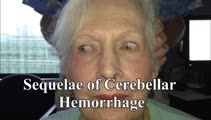 |
Sequelae of Cerebellar Hemorrhage - Gaze-evoked Nystagmus, Alternating Skew Deviation and Palatal Tremor | This is a 75-yo-woman presenting with a gait disorder. Two years prior, she suffered a cerebellar hemorrhage. On examination, there were typical cerebellar ocular motor signs including gaze-evoked nystagmus, choppy smooth pursuit and VOR suppression, and saccadic dysmetria. There was also an alterna... | Assessing Abnormal Alignment; Jerk Nystagmus; Gaze Evoked Nystagmus; Oculopalatal Myoclonus |
| 129 |
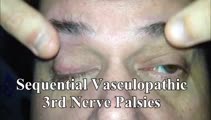 |
Sequential Vasculopathic 3rd Nerve Palsies with Preserved 4th Nerve Function | 65-yo-man with uncontrolled diabetes who developed sequential vasculopathic 3rd nerve palsies. In attempted downgaze, there's clear incyclotorsion OU suggestive of preserved 4th nerve function on both sides. There was complete recovery over months. Video shows bilateral 3rd nerve palsies with intact... | Third (Oculomotor) Nerve Palsy; Third Subnuclear |
| 130 |
 |
Sitting & Walking Oscillopsia in a Patient with Bilateral Vestibular Loss & Head Tremor | This is a 55-year-old man with oscillopsia for two reasons: He experienced oscillopsia at rest - so-called ‘sitting' oscillopsia - not from spontaneous nystagmus, but because of a combination of bilateral vestibular loss (BVL) and a mainly horizontal head tremor (this is sometimes referred to a... | Vestibulo-Cochlear Nerve |
| 131 |
 |
Skew Deviation and the Triad of the Ocular Tilt Reaction (OTR) | This is a patient who presented with vertical diplopia, who was found to have a complete ocular tilt reaction including the following features: (1) Skew deviation - right hypertropia that was about 30 prism diopters in all directions of gaze including right, left, up, down, as well as in right and ... | |
| 132 |
 |
Slow Abducting Saccade in 6th Nerve Palsy | 40-yo-man with a right fascicular 6th nerve palsy due to stroke. There was improvement and only a minimal residual right abduction paresis OD by this visit, but still a relatively slow right abducting saccade seen in the video, especially apparent in the slow motion segment. Video shows slow abduct... | Sixth (Abducens) Nerve Palsy; Abnormal Saccades |
| 133 |
 |
Slow Horizontal, Vertical and Oblique Saccades in Spinocerebellar Ataxia Type I | This is a patient presenting with horizontal diplopia who was found to have divergence insufficiency, an esotropia greater at distance than near in the absence of abduction paresis. She also had very slow saccades, more so vertically than horizontally. This is particularly noticeable when asking h... | |
| 134 |
 |
Slow Horizontal, Vertical, Oblique Saccades and Gaze-evoked Nystagmus in Anti-AGNA-1 Encephalitis | This is a patient who presented subacutely with imbalance and dizziness. On examination, she had evidence of gaze evoked nystagmus, right internuclear ophthalmoplegia, as well as slow saccades horizontally and vertically. She was diagnosed with a rare antibody-mediated disorder, anti-AGNA-1 (antig... | |
| 135 |
 |
Spinocerebellar Ataxia Type 3 with Gaze-Evoked Nystagmus and Bilateral Vestibular Loss | 𝗢𝗿𝗶𝗴𝗶𝗻𝗮𝗹 𝗗𝗲𝘀𝗰𝗿𝗶𝗽𝘁𝗶𝗼𝗻: This is a 50-year-old woman with an established diagnosis of spinocerebellar ataxia type 3 (SCA 3) with severe imbalance and head movement-induced oscillopsia. On examination, she had 1) bilateral vestibular loss (BVL) de... | Jerk Nystagmus; Gaze-Evoked Nystagmus; Abnormal VOR-HIT; Eighth Nerve; Abnormal Pursuit |
| 136 |
 |
Spontaneous Torsional Nystagmus and Ocular Tilt Reaction | 𝗢𝗿𝗶𝗴𝗶𝗻𝗮𝗹 𝗗𝗲𝘀𝗰𝗿𝗶𝗽𝘁𝗶𝗼𝗻: This is a 70-year-old man who experienced "a delay in focusing" with "some twisting movement" that began about 18 months prior to this video with mild progression over days or weeks. For the same period of time, he experi... | Jerk Nystagmus; Rotary Nystagmus; Abnormal Alignment |
| 137 |
 |
Square Wave Jerks and Macrosaccadic Oscillations in a Patient with a Cerebellar Tumor | This is a 40-year-old man who developed severe headaches, confusion, and gait imbalance which led to neuroimaging which demonstrated a midline cerebellar mass with compression of the fourth ventricle and obstructive hydrocephalus. He underwent a suboccipital craniectomy for resection of the mass, an... | Abnormal Saccades; Square Wave Jerks |
| 138 |
 |
Subtle Torsional Pendular Nystagmus in Oculopalatal Tremor (OPT) | 𝗢𝗿𝗶𝗴𝗶𝗻𝗮𝗹 𝗗𝗲𝘀𝗰𝗿𝗶𝗽𝘁𝗶𝗼𝗻: This is a 50-year-old woman who presented with imbalance, and MRI demonstrated a right cerebellar cavernous malformation. She underwent surgery to resect the malformation, and post-operatively experienced right hemiparesi... | Pendular Nystagmus; Oculopalatal Tremor |
| 139 |
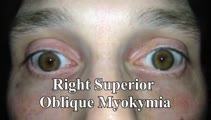 |
Superior Oblique Myokymia (SOM) | 𝗢𝗿𝗶𝗴𝗶𝗻𝗮𝗹 𝗗𝗲𝘀𝗰𝗿𝗶𝗽𝘁𝗶𝗼𝗻: This is a patient with transient monocular oscillopsia OD and vertical diplopia noted to have many episodes of SOM in the office. There was not only myokymia OD, but also a 4 prism diopter left hypertropia during episodes... | Superior Oblique Myokymia; Transient Monocular Oscillopsia; Vertical Diplopia |
| 140 |
 |
Superior Oblique Myokymia - Three Patients with Recorded Attacks Using VOG and Frenzel Goggles | 𝗢𝗿𝗶𝗴𝗶𝗻𝗮𝗹 𝗗𝗲𝘀𝗰𝗿𝗶𝗽𝘁𝗶𝗼𝗻: Patients with superior oblique myokymia (SOM) commonly present with complaints of monocular oscillopsia and/or vertical diplopia, which are related to the primary and secondary actions of the SO (incycloduction and depres... | Superior Oblique Myokymia; Fourth Troclear Nerve; Abnormal Alignment |
| 141 |
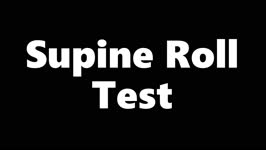 |
Supine Roll Test | Supine roll test: used to test for horizontal canal (HC) BPPV. While horizontal nystagmus due to HC-BPPV is often seen with DH, the roll test will usually maximize nystagmus and vertigo with the HC variant. The patient can be guided through a self-administered supine roll test while lying on the flo... | Supine Roll Test |
| 142 |
 |
Test Your Knowledge - Ocular Tilt Reaction and Subjective Visual Vertical | Lesions of which of the following neuro-anatomic structures could result in the clinical findings shown? A. Right medulla B. Right interstitial nucleus of Cajal C. Right medial longitudinal fasciculus D. Left trochlear nerve E. Right caudal midbrain A. Correct. This patient presents with elements... | Skew |
| 143 |
 |
Test Your Knowledge - Parinaud's Syndrome in Neurosarcoidosis | Watch the first segment of the video up to "Stop! What would you expect with vertical gaze?" and select the best response below. The patient also has mild right-beating nystagmus which can be ignored for the purposes of this question. A. The patient has pupillary findings consistent with bilateral 3... | Normal Convergence; Vertical Gaze Palsy; Upgaze Palsy; Dorsal Midbrain; Mesencephalon; Convergence Retraction |
| 144 |
 |
Third and Sixth Nerve Palsies Due to Cavernous Sinus Meningioma | This is a 60-year-old woman with a large meningioma that was compressing the right cavernous sinus. Examination demonstrated a pupil-involving right 3rd nerve palsy with near complete external ophthalmoplegia (involving levator palpebrae, medial rectus, superior rectus, inferior rectus). There was a... | Third Nerve Palsy; Fourth Nerve Palsy; Sixth Nerve Palsy |
| 145 |
 |
Third Nerve Palsy Due to Tolosa Hunt Syndrome | This is a 20-year-old woman presenting with severe left eye pain and diplopia for several days. Examination was consistent with a pupil sparing left 3rd nerve palsy with complete external ophthalmoplegia (involving levator palpebrae, medial rectus, superior rectus, inferior rectus). Abduction OS was... | Third Nerve Palsy; Tolosa Hunt Syndrome |
| 146 |
 |
Torsional Jerk Nystagmus | Presented here are 3 patients with torsional jerk nystagmus. The first patient presented with vertigo and experienced oscillopsia due to her torsional nystagmus. Pure or predominantly torsional nystagmus is highly suggestive of a central process. Her nystagmus was unidirectional and followed Alexand... | Medulla; Cerebellar; Jerk Nystagmus; Rotary Nystagmus |
| 147 |
 |
Torsional Nystagmus Due to Medullary Pilocytic Astrocytoma | 𝗢𝗿𝗶𝗴𝗶𝗻𝗮𝗹 𝗗𝗲𝘀𝗰𝗿𝗶𝗽𝘁𝗶𝗼𝗻: This is a 30-year-old woman who experienced headaches which led to an MRI and the diagnosis of a right medullary pilocytic astrocytoma, confirmed pathologically. Examination was performed a year after the initial diagnosi... | Jerk Nystagmus; Rotary Nystagmus; OMS Medulla |
| 148 |
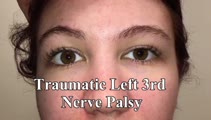 |
Traumatic 3rd Nerve Palsy with Aberrant Regeneration | 𝗢𝗿𝗶𝗴𝗶𝗻𝗮𝗹 𝗗𝗲𝘀𝗰𝗿𝗶𝗽𝘁𝗶𝗼𝗻: This is a 20-yo-woman who experienced severe head trauma and diplopia upon awakening from a coma several weeks after the injury. She had a partial left 3rd nerve palsy (adduction spared), and when she looked to the right ... | Third Nerve Palsy; Third Subnuclear Palsy; Aberrant Regeneration |
| 149 |
 |
Trigeminal, Facial (with Aberrant Regeneration), and Vestibulocochlear Nerve Palsies Following Tumor Resection | This is a 30-yo-woman who underwent resection of a right trigeminal schwannoma. Post-operatively, she was vertiginous with a clearly + head impulse test to the right (and spontaneous left-beating nystagmus), had lost hearing in the right ear, had no facial sensation on the right, and had a right low... | Vestibulo-ocular Reflex and Head Impulse Testing Abnormal; Facial Nerve |
| 150 |
 |
Two Patients with Parinaud's Syndrome with Slow Upward Saccades and Normal Upward Range of Movements | Presented here are two patients with Parinaud's syndrome: Patient 1) suffered a hemorrhage of the dorsal midbrain causing slow upward saccades (with convergence retraction nystagmus, but normal vertical range of eye movements), and light-near dissociation, and Patient 2) had a germinoma of the dorsa... | Abnormal Saccades; Dorsal Midbrain; Jerk Nystagmus; Gaze Evoked Nystagmus |
